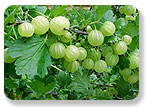|
|
|
|
|
AMLA |
|
Name of the Commodity : Amla |
 |
|
Botanical Name : Emblica officinalis. |
|
Family :
EUPHORBIACEAE |
|
Synonyms |
|
Eng:
Emblic myrobalan tree, Indian gooseberry
Hindi: Amalaki, Amla, Amlika, Aonla, Anuli,
Anvula, Anvurah, Anwered, Aungra, Aunra, Daula
Malayalam: Amalakam, Nelli, Nellimaram,
Nelikka
Oriya: Khondana, Onola, Anda, Anala, Amla,
Amlaki
Punjabi: Ambal, Ambli, Amla, Aonla, Ambul
Telgu: Amalakamu, Amalaki, Nelli,
Pullayusirika, Triphalamu, Usirika, Usirikaya,
Usiriki, Usri
Tamil: Amalagam, Andakoram, Indul, Kattunelli,
Nelli, Perunelli Sirottom, Tattiri, Toppunelli,
, Nelli-kai, Nellimar; |
| |
|
Description |
|
A
moderate- sized deciduous tree found wild or
planted throughout the deciduous forests of
tropical India. It is also cultivated in large
scale in the states of Jharkhand, U.P., Mahdya
Pradesh, Rajasthan, Karnataka, Kerala,
Maharashtra etc. Amla tree start bearing
fruits in seven to eight years after planting
while the budded clones start bearing fruits
from the fifth year onwards. The fruits are
light green at first, changes into dull
greenish yellow on maturity. Appropriate
harvesting time for Amla fruits is February
when the fruits have maximum ascorbic acid
content. In South India, fruits are found
throughout the year. The mature fruits are
hard and they do not fall by gentle touch and
therefore vigorous shaking is required. For
getting attractive prices, grading of fruits
on the basis of size should be done after
harvesting. |
| |
|
Parts Used |
|
Dried Fruit, Fresh Fruits, Leaves, Root bark
and Flowers |
| |
|
Yield |
|
A
matured tree of about 10 years will yield
50-70 kg. of fruit. The average weight of the
fruit is 60-70 g. One kg. Contains 15-20
number of fruits. A well-maintained tree can
give yield up to an age of 70 years. The yield
decreases with the increase of age of tree. |
| |
|
Varieties |
|
Depending on the size of the fruit and place
of origin there are various varieties of Amla
like Vanarasi Chakiya, Francis, Krishna,
Kanchan etc. |
| |
|
Uses |
|
Amla
fruit is an ingredient of many compound
formulation. It is generally used in
combination with two other Myrobalans (Harad
and Baheda) . A fixed oil extracted from the
fruit is reported to have the property of
promoting hair growth. “Triphala” consisting
of equal part of emblic, cheublic and belleric
myrobalans(Phyllanthus emblica, Terminalia
chebula and Terminalia bellirica) is used as a
laxative and in headache, biliousness,
dyspepsia, constipation, piles, enlarged
liver. |
| |
|
Trading of Amla |
|
Fresh Amla is mainly consumed by pharmacies
for preparation of Chayawanparash. For
procuring fresh Amla pharmacies generally
enter into buy back agreement with the
farmers/cultivators before the start of the
season. Fresh Amla is also procured from fruit
and vegetable mandies.
The dried Amla is collected from the wild
/produced by cultivation and marketed in
various APMC Mandis. The agents of the traders
of big cities give the supply to them and in
turn big traders sell the product to the end
users mainly manufacture of the Indian System
of Medicines. |
|
|
| |
|